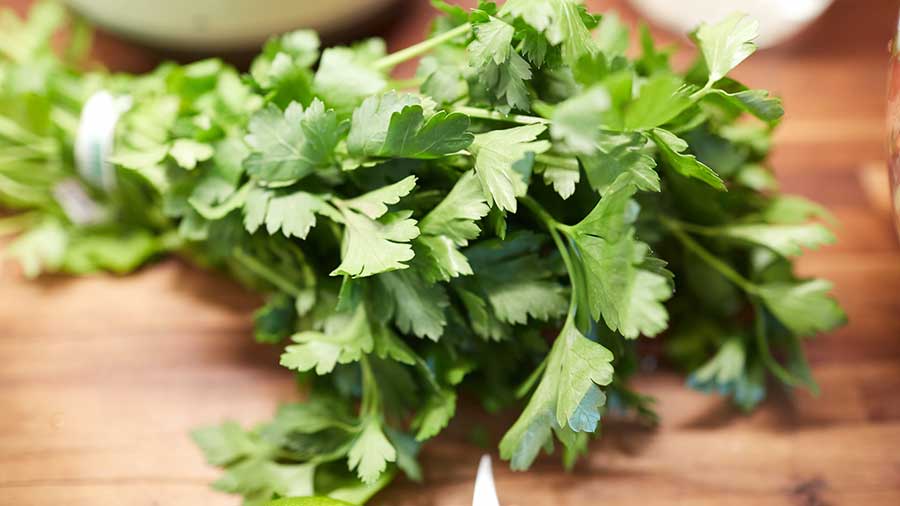A classic garnish for savory dishes, parsley is also a tasty addition to an herb or leaf salad, particularly Italian or flat-leaf parsley. It is a good source of folate, iron, and vitamin C.
Parsley is ideal for garnishes and flavoring. The nutritious leaves are high in iron and vitamins A, C, and E. Its high chlorophyll content also makes it a natural breath sweetener, too.
The entire herb—stem and all—can be used for flavoring stocks, soups, and sauces, but more often the leaves are stripped from the stems and chopped before adding to a recipe. They can be used as an ingredient in recipes such as meatballs and meatloaf or added as a flavoring at the end of cooking. Whole leaves can be incorporated into salads and used as a garnish.
With all its benefits, it is a good idea to always have a fresh supply of parsley in your house. Here are some ideas in growing parsley:
- Parsley grows well in containers
- Parsley is fairly easy to grow from seeds
- Parsley is rich in vitamin A, C, and E. It is also rich in potassium
- Parsley can be made into a tea or infusion
- Parsley can be used for flavoring stocks, soups, and sauces
How to Grow Parsley From Seeds
Parsley grows slow. Because it requires low maintenance, however, and can live up to nearly two years, parsley is a good choice for your herb garden. It also grows well in containers. As a tip, do not cut the initial leaves of the parsley plant.
Fill a seed tray with seeding media or soil mix. Sprinkle with water. Poke the soil. Place 1-2 seeds in each hole, then lightly cover with media. Thin to one seedling per hole when true leaves are already developed.
Transplant or transfer the seedling in the plot or large pot for the plant to grow. Dig a hole in the soil and place the seedling.
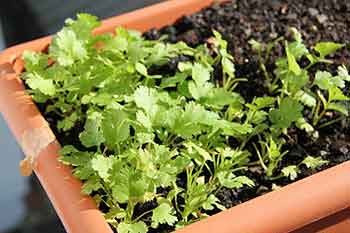
Cover the roots with soil and press lightly. Water the seedling after transplanting. Keep soil moist after planting until plants are well-rooted. Plants grow best with adequate moisture.
In containers, irrigate whenever the soil is dry.
Tips for Harvesting Parsley
When harvesting Italian Parsley, cut leaves from the outer portions of the plant and allow the inner portions to mature. To store in the refrigerator, wrap unwashed stems in a paper towel. Slip the bundle into a tightly closed plastic bag. Use within 7 to 10 days.
For longer storage, freeze leaves individually on a parchment-lined tray, in a single layer in a freezer bag, or in ice cubes (chop leaves first).
Parsley is an Excellent Source of Vitamin A, C, and Calcium
For every 1 tablespoon of parsley (3.8 grams), it contains 21.1 mg of potassium. This is based on the US Department of Agriculture (https://fdc.nal.usda.gov). A 1/2 cup (30 grams) of fresh, chopped parsley also provides 11% of the Reference Daily Intake (RDI).
It also contains 6% DV of vitamin A and 8% DV of vitamin C. Percent Daily Values (%DV) are for adults or children aged 4 or older and are based on a 2,000 calorie reference diet. Basically, it means that 1 tbsp of parsley provides 8% of the vitamin C you need per day.
Potassium
Along with sodium, is important in maintaining fluid balance and regulating blood pressure and is essential for the transmission of nerve impulses. It is important in muscle contraction and proper regulation of the heart's rhythm.
Vitamin A
Vitamin A is essential for healthy vision, eyes, skin, and growth. It can also be obtained from beta-carotene, the pigment found in highly colored fruit and vegetables. In addition to acting as a source of vitamin A, beta-carotene has an important role to play as an antioxidant in its own right.
It also acts as an antioxidant, thus helping to protect the cells against cancer and other diseases.
Vitamin C
Vitamin C is essential for growth and vital for the formation of collagen (a protein needed for healthy bones, teeth, gums, blood capillaries, and all connective tissue). It plays an important role in the healing of wounds and fractures and acts as a powerful antioxidant.
Folate
Folate or folic acid is one of the B vitamins. It is water-soluble and cannot be stored so it has to be part of one's daily diet. All B vitamins help the body convert carbohydrates into glucose to produce energy.
Folic acid, however, has additional health benefits such as assisting in the production of DNA and RNA, the body's genetic material during fetal development and childhood days when cells and tissues are growing rapidly.
Folic acid also facilitates the formation of red blood cells, preventing anemia.
Health Benefits of Parsley
Traditionally used to control body odor and bad breath, parsley contains aromatic volatile oils and cleansing chlorophyll, which support the absorption of food and help to get rid of toxins that can increase foot odor. It’s also a good source of zinc, which combats bad smells.
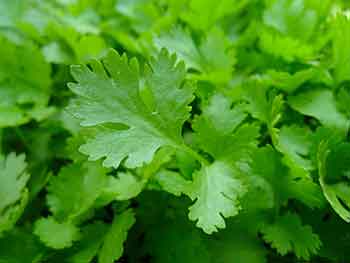
Other health benefits of parsley:
- Acts as blood purifier (chlorophyll)
- Detoxifies the body (apigenin, myristicin)
- Eliminates waste from kidneys and liver (diuretic action)
- Fights allergies and persistent inflammatory disorders (essential oil)
- Improves urine flow and kill bacteria that cause urinary tract conditions (myristicin, apiole)
- Enhances vision (vitamin A)
- Protects heart form stroke, attack, and atherosclerosis (folate)
- Clears skin pores to prevent acne breakout (astringent property)
- Leads to faster growth of new skin resulting to a blemish-free and smooth skin (vitamin C)
- Speeds-up healing of wounds (beta-carotene, histidine)
Parsley Preparation for Body Care
Facial treatment
Boil 1 tbsp dried parsley leaves in 1 cup water. Let cool. Rinse face with this liquid at least once a day. Fresh preparation is better to obtain maximum benefits.
Clogged pores
Pour 1 cup of boiling water over a handful of parsley. Cover container and steep until cool. Strain and apply the liquid to your face as a compress for about 15 minutes.
Gentle reminders
- Because of its high oxalic content, prolonged parsley consumption may lead to headache or cause gouty arthritis, kidney stones, and mineral-nutrient deficiency
- Too much parsley can be particularly problematic for people suffering from kidney stones
How to Make a Tea from Parsley
When you pour boiling or very hot water on fresh or dried parts of a plant and let it soak or steep for a minute or two, you’re generally preparing an herbal tea. When you do this, you get to enjoy the flavor and aroma of the herb and spice in the water you’ll be drinking.
But to get the most benefit out of the plant, you may need to let it steep longer. When you do this, you’re now making an infusion. Infusion is actually caffeine-free.
Making a Fresh Parsley Infusion
Pour 1 cup of boiling water into a handful of leaves. Cover and steep for at least 10 minutes. Cool and strain
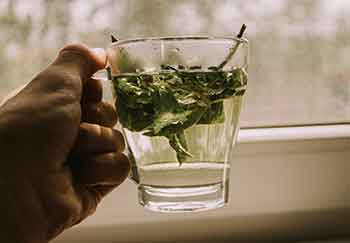
Infusion from Dried Parsley Leaves
Pour 1 cup of boiling water into 2 teaspoons of dried leaves. Cover and steep for at least 10 minutes. Cool and strain.
Note: Parsley leaves are slightly bitter. Sweeten with honey and a bit of lemon juice to enhance flavor.
Parsley Cooking Ideas
With plenty of parsley leaves at home, I searched for recipes where I can get creative in the kitchen. These are just some of the recipes I found.
Parsley Smoothie
Smoothies are drinkable meals or snacks that are fast and easy to prepare. Throw in a combination of fruits, greens, and milk and you have a delightful drink packed with fiber and carbohydrates, vitamins and minerals, proteins, and good fat.
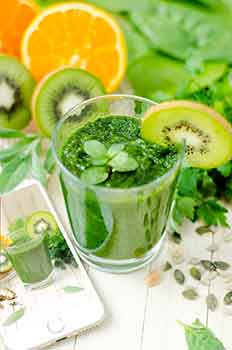
1 bunch flat-leaf parsley
2 pieces medium lemon, peeled, seeded
1 green apple, cored, chunked, and frozen
1 inch ginger, coarsely chopped
1 cucumber
1 teaspoon honey
Crushed ice
Blend everything and strain.
Parsley-Sweet Potato Fries
½ kilo unseasoned sweet potato
¼ teaspoon rosemary, crushed
1 tablespoon olive oil
½ teaspoon salt
¼ cup Parmesan cheese, grated
1 tablespoon parsley, chopped
Put together fries, rosemary, oil, and salt in a bowl and toss to coat well. Line baking pan with foil coated with nonstick cooking spray and spread tossed fries in a single layer. Bake in 400 deg F for about 25 minutes or until tender and golden brown, turning fries occasionally.
Sprinkle with Parmesan cheese and parsley, turning to coat evenly. Serve with rosemary balsamic ketchup, if desired.
Vegetable Stock
Use this light stock as a base for delicate soups and sauces, and in risottos and similar dishes. It will keep in the fridge for up to 5 days or in the freezer for up to 1 month.

Makes about 1.7 liters (3 pints)
15 g (1/2 oz) butter
225 g (8 oz) leeks, chopped
225 g (8 oz) onions, chopped
1 large bay leaf
Several sprigs of fresh thyme
Several sprigs of fresh parsley, stalks bruised
225 g (8 oz) carrots, diced
150 g (5 ½ oz) celery, diced
1 tsp salt
5 black peppercorns
Preparation time: 15 minutes
Cooking time: 1 hour
- Melt the butter in a large saucepan or stockpot over moderate heat. Stir in the leeks and onions, then reduce the heat to low. Cover with a tight-fitting lid and leave the vegetables to “sweat” for 20 minutes without lifting the lid.
- Tie the herbs together into a bouquet garnish. Add it to the pan with the carrots, celery, salt, peppercorns, and 2 liters (3 ½ pints) of cold water. Increase the heat and bring slowly to a boil, skimming the surface if necessary to remove any scum. As soon as the water boils, reduce the heat to low and simmer for 35 minutes.
- Strain the stock into a large heatproof bowl and set it aside to cool. Use immediately, or transfer to tightly sealed jars or freezer containers for storage.
Crisp Cucumber Salsa
1 cup cucumber pulp
1 ½ cup seeded tomatoes, chopped
¼ cup red onion, chopped
2 tbsp parsley, minced
1 pc jalapeno, seeded and chopped
4 ½ tsp cilantro, minced
1 clove garlic, minced
¼ cup sour cream
½ tsp lemon juice
½ tsp lime juice
¼ tsp ground cumin
Tortilla chips
- Mix the first seven ingredients
- In another bowl, combine sour cream, lemon juice. Lime juice, and cumin
- Pour over cucumber mixture and toss gently to coat
- Serve immediately with tortillas
Penne Pasta Primavera
This classic Italian dish is intended to make the very most of young produce, freshly picked from the vegetable plot. With today’s choice of vegetables in supermarkets, the selection can be varied for year-round meals, and the recipe can also be made as a “storecupboard supper” with good-quality frozen vegetables
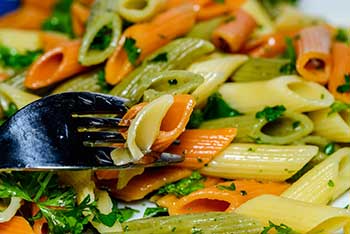
Serves 4
340 g (12 oz) penne or other pasta shapes
170 g (6 oz) young asparagus
170 g (6 oz) green beans, trimmed and cut into 3 cm (1 ¼ in) lengths
170 g (6 oz) shelled fresh peas
1 tbsp extra virgin olive oil
1 onion, chopped
1 garlic clove, chopped
85 g (3 oz) pancetta, chopped
115 g (4 oz) button mushrooms, chopped
1 tbsp plain flour
240 ml (8 fl oz) dry white wine
4 tbsp single cream
2 tbsp chopped mixed fresh herbs, such as parsley and thyme
Salt and pepper
Preparation time: 15 minutes
Cooking time: 15 minutes
- Cook the pasta in boiling water for 10-12 minutes, or according to the packet instructions, until al dente. Drain well.
- While the pasta is cooking, cut the asparagus stalk, the green beans, and peas into a saucepan of boiling water. Bring back to a boil and cook for 5 minutes. Add the asparagus tips and cook for a further 2 minutes. Drain thoroughly.
- Heat the oil in a saucepan. Add the onion and cook for 3-4 minutes or until softened. Add the garlic, pancetta, and mushrooms, and continue to cook, stirring occasionally, for a further 2 minutes.
- Stir in the flour, then gradually pour in the wine and bring to a boil, stirring. Simmer until the sauce is thickened. Stir in the cream and herbs, with seasoning to taste. Add the vegetables to the sauce and heat gently for 1-2 minutes, without boiling.
- Divide the pasta among 4 serving bowls and spoon the sauce over the top. Serve immediately.
References
Hendy, Jenny. 2011. Kid’s First Gardening Book. Lorenz Books, Anness Publishing Ltd
Reader’s Digest. Eat Yourself Healthy. Reader’s Digest Association Limited
Villaflor-Almocera, Evelyn. 2017. Healthy Foods Healthy Lives. Philippines: Philippine Publishing House
Gealone-Corpus, Arlene May. 2018. Healthy Herbs and Spices. Philippines: Philippine Publishing House


